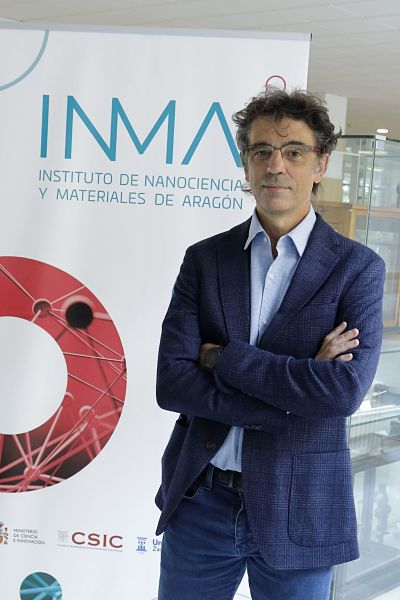INMA researchers involved in the creation of a material in a mixed state light-matter
An international team involving researchers from the CSIC and the Centro Universitario de la Defensa (CUD) of Zaragoza at the Instituto de Nanociencia y Materiales de Aragón, INMA, (CSIC – University of Zaragoza), has developed a material that contains infrared light trapped in its atoms, even when it is not illuminated.
The results obtained in this research, led in the theoretical part by INMA and in the experimental part by the University of Minnesota, could allow the development of new optoelectronic devices (combining light and electronics) of new generation, based on quantum technologies.
The great importance of the research results has led to their publication in the prestigious international journal Nature Photonics.
Quantum physics studies the natural phenomena of light and matter at the smallest scales. In this study, researchers have developed an innovative process that enables “ultra-strong coupling” between infrared light (photons) and the atomic vibrations of matter (phonons) by trapping light in tiny annular holes, about 2 nanometres in diameter (25,000 times smaller than the width of a human hair), in a thin gold foil. These nanocavities, similar to a very small version of the coaxial cables used to send electrical signals (such as the input cables to televisions), were filled with silicon dioxide, which is essentially the material that makes up window glass. Using the technologies used in computer chip design, millions of these cavities were produced, all of which simultaneously exhibited this ultra-strong photon-vibration coupling.
“Fascinatingly, in this coupling regime, the vacuum is not empty. Instead, it contains photons with wavelengths determined by molecular vibrations. Moreover, these photons are extremely confined and are shared by a minimum number of molecules,” says one of the lead authors of the paper, Professor Luis Martín Moreno from the Instituto de Nanociencia y Materiales de Aragón (INMA), and from the Aragon Government’s Group of Excellence “Quantum Materials and Devices” (QMAD).
“Normally, we think of the vacuum as basically nothing, but it turns out that this vacuum fluctuation always exists,” says the study’s other lead author, Sang-Hyun Oh, professor of electrical and computer engineering at the University of Minnesota. “This is an important step towards harnessing this so-called zero-energy fluctuation to do something useful.”
“The nanocavities we have designed allow us to modify the way light and matter interact. By varying their dimensions in a controlled way, we can move from the weak to the ultra-tight coupling regime. Our next goal is to use these devices as ‘nanolaboratories’, where we will test different materials and evaluate new theories,” says another of the authors, Dr. Fernando de León Pérez, Associate Professor at the Centro Universitario de la Defensa de Zaragoza and PhD at INMA.
The interaction between light and matter is fundamental to life on earth: it enables plants to convert sunlight into energy and allows us to see the objects around us. Infrared light, with wavelengths much longer than we can see with our eyes, interacts with the vibrations of atoms in materials. For example, when an object is heated, the atoms that make up the object begin to vibrate faster, emitting more infrared radiation, which allows thermal imaging with night-vision cameras.
Conversely, the wavelengths of infrared radiation that are absorbed by materials depend on what kind of atoms make up the materials and how they are arranged, so chemists can use infrared absorption as a ‘fingerprint’ to identify different chemicals.
These and other applications can be improved by increasing the intensity with which infrared light interacts with the atomic vibrations of materials. This, in turn, can be achieved by trapping light in a small volume. Trapping light can be as simple as having it reflected multiple times between a pair of mirrors, but much stronger interactions can be obtained by using nano-scale metallic structures, or “nanocavities”, to confine light to ultra-small length regions.
When this happens, the interactions can be strong enough for the quantum-mechanical nature of light and vibrations to come into play. Under such conditions, light (photons) in the nanocavities and atomic vibrations (phonons) in the material exchange their energy so rapidly that they can no longer be distinguished. When this happens, these strongly coupled modes result in behaviour that is part light and part vibration at the same time, forming new quantum mechanical objects known as “polaritons”.
The stronger the interaction becomes, the more unique and surprising the quantum effects that can occur. If the interaction becomes strong enough (in the regime known as “ultra-strong”) it may be possible to create photons from the vacuum or make chemical reactions unfold in ways that would otherwise be impossible.
Sang-Hyun Oh says, “Others have studied the strong coupling of light and matter, but with this new process to design a version of nano-sized coaxial wires, we are getting into ultra-strong coupling situations, which means we are discovering new quantum states where matter and light can have very different properties than they do every day, and in fact, we see completely unusual things starting to happen. “This ultra-strong coupling of light and atomic vibrations opens up all kinds of possibilities for developing new quantum devices or modifying chemical reactions.
The research has been developed by a Spanish-US interdisciplinary team formed by Fernando de León Pérez, Associate Professor at the Centro Universitario de la Defensa de Zaragoza and PhD at INMA; Luis Martín Moreno, Research Professor at INMA; Sang-Hyun Oh, Professor of electrical and computer engineering at the University of Minnesota; Matthew Pelton of the University of Maryland; Markus B. Raschke of the University of Colorado, Colorado State University; and Matthew Pelton of the University of Maryland. Raschke of the University of Colorado Boulder and Joshua D. Caldwell of Vanderbilt University.
The research of the INMA group has been funded by the Ministry of Economy and Competitiveness of Spain and the Government of Aragon.
11/12/2020











